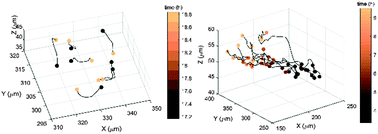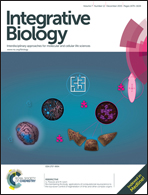Collective motion of mammalian cell cohorts in 3D†
Abstract
Collective cell migration is ubiquitous in biology, from development to cancer; it occurs in complex systems comprised of heterogeneous cell types, signals and matrices, and requires large scale regulation in space and time. Understanding how cells achieve organized collective motility is crucial to addressing cellular and tissue function and disease progression. While current two-dimensional model systems recapitulate the dynamic properties of collective cell migration, quantitative three-dimensional equivalent model systems have proved elusive. To establish such a model system, we study cell collectives by tracking individuals within cell cohorts embedded in three dimensional collagen scaffolding. We develop a custom algorithm to quantify the temporal and spatial heterogeneity of motion in cell cohorts during motility events. In the absence of external driving agents, we show that these cohorts rotate in short bursts, <2 hours, and translate for up to 6 hours. We observe, track, and analyze three dimensional motion of cell cohorts composed of 3–31 cells, and pave a path toward understanding cell collectives in 3D as a complex emergent system.


 Please wait while we load your content...
Please wait while we load your content...